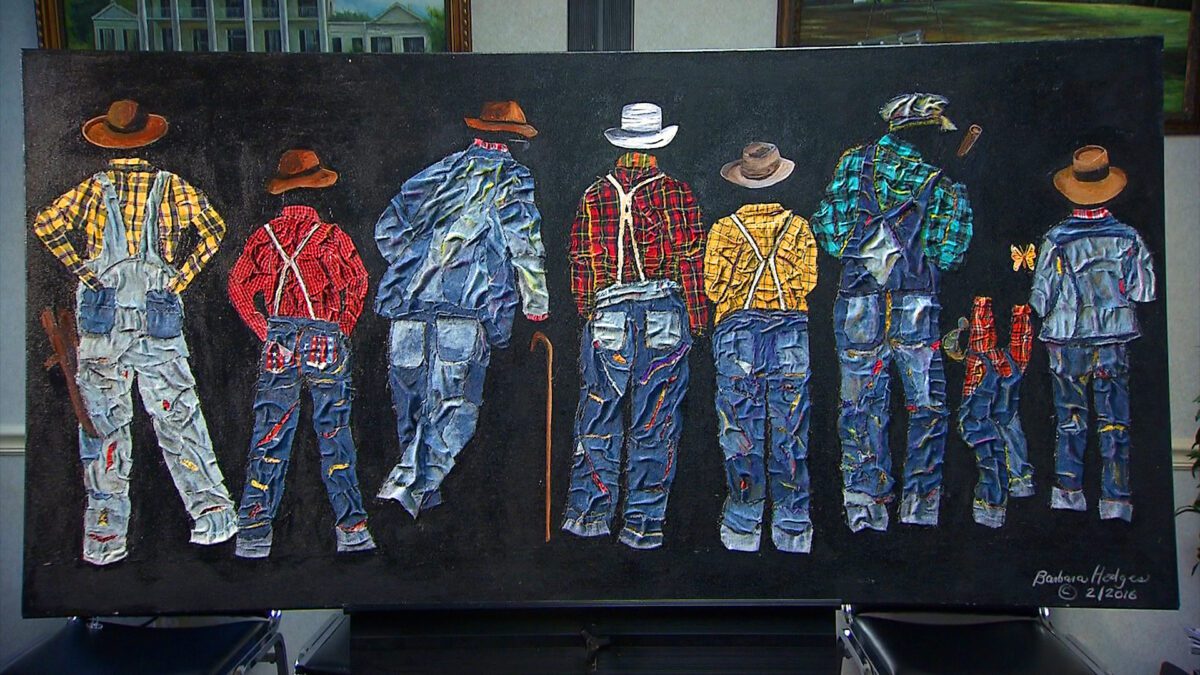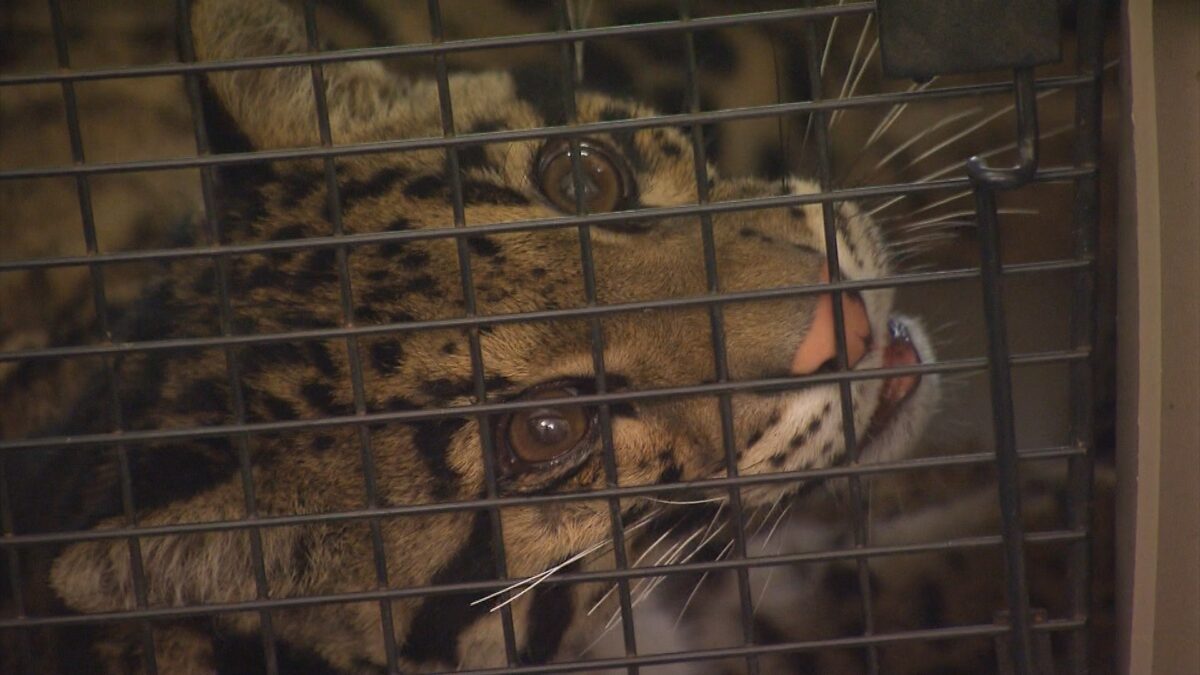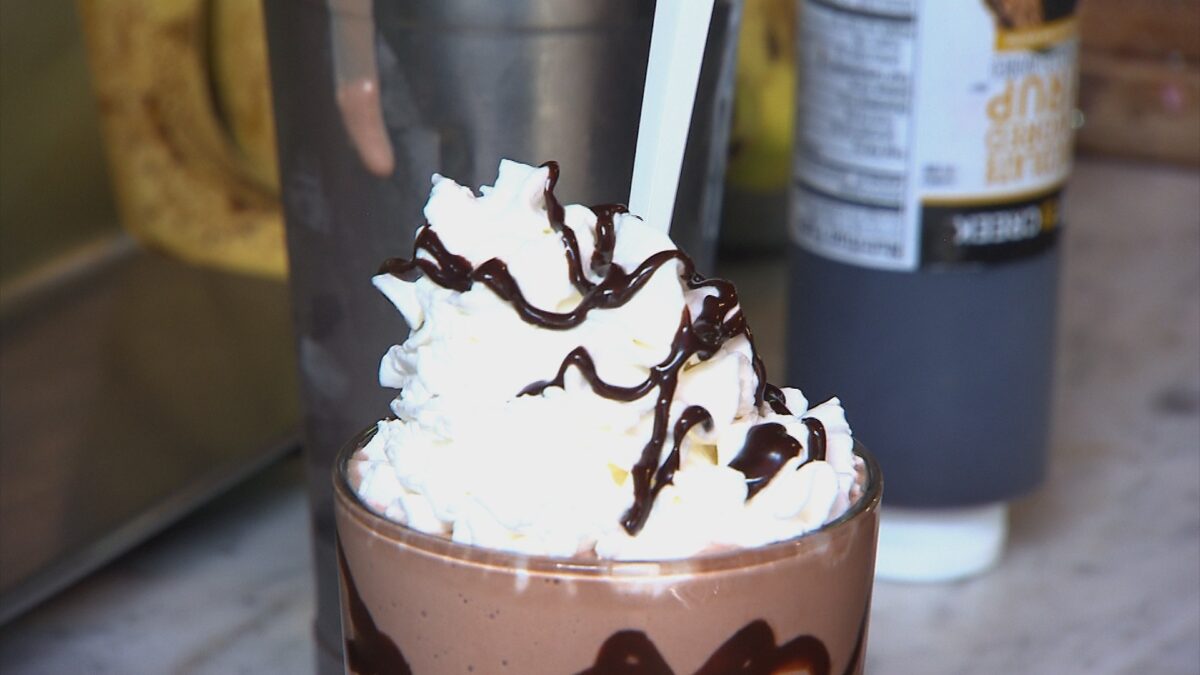Episode 3812
Don't have the PBS App? Click Here
Episode Transcript
- [Announcer] "Tennessee Crossroads" is made possible in part by. - [Narrator] Some of our biggest checks have also made the biggest difference. The Tennessee Lottery, proud to have raised more than $7.5 billion for education. Now that's some game-changing, life-changing fun. - [Announcer] Discover Tennessee Trails and Byways. Discover Tennessee's adventure, cuisine, history, and more made in Tennessee experiences showcased among these 16 driving trails. More at tntrailsandbyways.com. - [Announcer] Middle Tennessee State University College of Liberal Arts helps students explore the world, engage minds, enrich lives, and earn a living. More at mtsu.edu/cla. - [Announcer] Amazon, a proud supporter of programming on public television. Amazon focuses on building long-term programs that have a lasting impact in communities where employees live and work. More at aboutamazon.com. - This week, we'll tour a Christmas display in Lebanon, meet a pair of artistic storytellers, satisfy your sweet tooth in Lynnville, and go absolutely wild at the Nashville Zoo. Hello everyone, I'm Miranda Cohen. Welcome to the latest edition of "Tennessee Crossroads." Well the holidays are just around the corner, and most of us are starting to think about decking the halls. In our first story, we'll head to Lebanon to meet a family who prepares for the Yuletide season all year long. And the results are breathtaking. - First thing that was in the back of a trailer. - [Miranda] Michael Scaff and his dedicated team are hard at work on this late summer day. - There you go. - [Miranda] And their efforts will soon transform the Wilson County fairgrounds into a holiday wonderland. - Most of my staff is family and close friends, and most of us travel from Bristol where we live. - [Miranda] Michael, his wife Melissa, and their daughter Addie will work all year attending to every detail of what many have come to know as a magical holiday memory. - We design all the displays and custom build them all. We don't buy things, we build them all. So that's what we do in the summer. We work on new music, we work on new displays, of course repair things that need repaired from previous years. - Lift up on it. - There you go. - It may not look like a Christmas wonderland now, but that is about to change. All thanks to the very hardworking Scaff family and about seven employees working 10 hours a day, seven days a week for about six weeks. This will turn into this. - [Family] Merry Christmas! - [Miranda] Welcome to "The Dancing Lights of Christmas." - [Michael] The show itself covers about 40 acres, and then we don't know how many lights we, we were two and a half million, but we kind of quit counting after we got to that point. - Look at that between. - [Michael] It's a drive-through event. The whole entire event's drive-through unless you want to get out and visit with Santa. So you just pull in, you tune your radio to a specific channel that we broadcast on, and the music and the lights are completely synchronized. They're synchronized down to the 10th of a second. So as you drive through, all 2 million lights will be going with the music exactly to the beat of the music the entire time. - [Miranda] The Scaff family has been making these 40 acres merry and bright for almost a decade, and it is bigger and better than ever. - As you drive around, if you're on the left side of a display, it may be doing one thing. By the time you circle around to the other side, the songs change. So that same tree, for example, will be doing something totally different. So it's pretty neat. And then every year, we also add something new. We always try to add one large new thing and then several small things. So to kind of keep it fresh and different. - [Miranda] If you plan to drive through, you'll be in good company, or you can always soar high above in a helicopter. - [Michael] He comes in, sets up his helicopter, operates out of Santa's village, and he will fly you above the lights. So you get to see the light show from the air, and then you can see of course all the cars, people waiting, and fly over the village and stuff. So that's a really unique way to see it. - [Miranda] "The Dancing Lights of Christmas" is one of the largest synchronized displays in the country, and one of the only shows that offer the bird's eye view. The extravaganza ends right in the heart of Santa's village, complete with bounce houses, horses, hot chocolate, and even the man himself. - Oh, we love him. This is a yearly tradition for us to see what's new and different. There's always something that we find that they didn't have the last year, and it gets bigger every year. - [Miranda] Everyone has a favorite part, from the singing snowmen to the twinkling trees, to the perfectly timed tunnels. And there is always a nod to the red, white, and blue, - All the veterans of this country and the current military and everyone who's ever served in a uniform, if they didn't do what they do, we couldn't do what we do. So we try to always remember that and honor that. - [Miranda] Each year, the Scaff family holds special events for veterans and donates the proceeds to projects like the Wounded Warrior Project, the Second Harvest Food Bank, the Ronald McDonald House, and many more. - [Michael] We've been able to do a lot of good with the show thanks to Middle Tennessee's participation in coming out to the show. - [Miranda] All 2 million lights will be twinkling from mid-November until early January. An unforgettable experience for both the visitors and for the family who makes all of the magic happen. - [Michael] It's pretty special. We celebrate Christmas obviously in a different way than most people because we're here working. But to be part of literally tens of thousands of families' Christmas tradition, it's a pretty good feeling. We've literally seen these people's families grow up, and including our family in their Christmas tradition. So it's just pretty neat to kind of feel included in so many people's Christmas. - Merry Christmas. - Merry Christmas. - Next, we'll meet a wonderful husband and wife team from Murfreesboro. While they are a computer programmer and a doctor by trade, they're also amazing artists who do a lot for their community. Laura Faber shares their journey and finds out why they have no plans to stop anytime soon. - [Laura] It's art that evolves from the human experience, the joy and the struggle, the pain and hope. It evokes emotion and memory. And that's exactly the intention of the artist. - Piece I'm working on today is called "Stepping Through Time." This young lady is looking at different aspects. This gonna be your globe and thing of that nature, it's a spear type of thing. So she's got a clock in there and as she moves through time itself. - [Laura] Leroy and Dr. Barbara Hodges are known as artistic storytellers in Murfreesboro. Their work, primarily oil paintings and multimedia pieces, carry messages important to them. They're known for their use of color, cubism, and a method they developed called the drip style. And they often work on pieces together. - When we get down to the actual coloring, I do a lot of that. Barbara would do a lot of the figuring work. That drip style, what you do, you put it on, you allow it to dry, and then you come back and you look at the imagery. And what Barbara does is go in and she'll sketch the imagery between the thing and I go in and fill it in. So we do a lot of that. If we're talking about a lot of fabric, then Barbara will do the fabric pieces of it. - And this is the part called sharing, going and taking some of his paint. You got white? Can I get some, please? - [Laura] While both create statement pieces, Barbara characterizes her style as folk art. Art that tells a story. This multimedia piece is titled "Wisdom of the Elders." - One of the greatest thing that people have in common is quilting. And these seniors actually did do a quilt. And so this is just showing how it's a family affair because back in the day, many families actually had two or three generations living under the same roof. And that's what it's depicting. So I love using the mixed media from paper to fabric. And actually I just take some old wallpaper, and just creating like the wrinkles here in this and just gluing this down. And I'm showing, actually, this is like a narrative within a narrative. It doesn't matter who's in the picture. When somebody looks at it, it actually brings back memories. And anybody can identify with it. This could be anybody's grandmother. That's a unique thing about doing folk art. Anybody can identify with with that and one can just simply tell their own story. - Though art has always been a part of the Hodges' lives, they each have completely different careers that they have worked alongside their art. They are just as comfortable using paintbrushes as they are using computers and a stethoscope. Leroy is a mathematician and computer programmer by trade. Barbara is a doctor, a family practitioner in private practice, which Leroy manages. Both are MTSU alums, and that's where they met. Their art education happened along their life journey. Leroy working for the federal government in DC, Barbara attending medical school in Wisconsin. - So I took an art class. That helped me to balance what I had to do with the learning and dealing with the challenges of going to medical school. It kept a nice balance in my life. So art has always been a very intricate part of my life. I always used that to incorporate, integrate when I had to deal with patients. - [Laura] Leroy caught the art bug from Barbara, and they both studied under local artists. Eventually, they ended up back in Murfreesboro where it all began, now married for 40 years. - [Leroy] We developed our own style and we both like color, so we start using it in a lot of our work. - And I need a color because I think as your journey into medicine, you see a lot of things. That has always given me a greater appreciation about life. I think about life that it's in color. - Art is part of our being, to be honest with you. It gives you a unique feeling as you start out with basically nothing. An empty canvas, a blank canvas. And from there, then you start adding the color to it, and you see it come alive. That gives you a very unique feeling. - [Laura] You can see their work in exhibits on the MTSU campus often and in town. They are strong community advocates. The Hodges host art classes for seniors and youth, exposing people to the joy of art. Most who have never held a paintbrush in their lives. At 71 and 65, Leroy and Barbara, even while working full-time, find time to paint and create every day. - Well I think art will always be a part of our life regardless of whether we are here working in the particular medical practice or whatever. Once Barbara decides to go ahead and retire, then we both probably do art full-time. - [Laura] The Hodges aren't slowing down anytime soon. - Thanks, Laura. In this age of chain restaurants, it's getting hard to find a good old fashioned soda parlor these days. Well, Cindy Carter found one in the tiny town of Lynnville. In fact, it boasts of having some of the best hamburgers and shakes in the whole state. - [Cindy] If you ever find yourself waywardly wandering through Tennessee, consider it very good fortune if you happen upon the small railroad town of Lynnville. Folks here have never met a stranger. But understand this, strangers are pretty easy to spot. - We love our town and we only got 326 people, and we love every one of them. - [Cindy] And Johnny Phelps, owner of the Soda Pop Junction, like most everyone else around here, can probably list almost all 326 names. - I'm ready if I ever get to - [Cindy] But everyone, locals, tourists, and wayward wanderers alike, all seem to eventually make their way to the junction. The Soda Pop Junction. A place known for its delicious award-winning burgers. And ice cream, by the shake, float, scoop, or sundae. - I get a chocolate milkshake about three or four times a week, just on a nice hot summer day, it's nice to have something to cool you down. - [Cindy] Cool down and catch up. That's what the locals do. - It's just a closeness here. And people have been very supportive. But 90% of our business comes from outside the area. - [Cindy] And that outside cash flow has given Lynnville new life, which is exactly what Phelps had in mind back in 1998 when he decided to buy this old building and turn it into a restaurant. - At that time, most of the buildings you see up and down the strip either had fell in or was no business. When I came to look at the building, it was raining. I mean just really, really rainy. Actually, I had to go to my car and get an umbrella to come in and look at the building because it was leaking so bad. - [Cindy] Well, to be fair, the building was built in 1860 at the height of the town's railroad boom. - [Johnny] I'm not crazy about running a restaurant, but I love the history and being around people. And that comes from 49 years of being a teacher. - [Cindy] So this former high school teacher invested in the past, and a colorful past it is. - It was a saloon on this side and it was two different buildings, but it's all under the same roof. And it was a drugstore on that side. You could get your medicine at both places back then, get it over there, or you could come in here and get it. Either way, you was gonna come out of here happy. - [Cindy] In 1928, the space became home to the L. E. Moore Drug Company, which like many drugstore of the day also sold ice cream and mixed together soda pop. The drugstore literally served this community for 50 years before shutting down, and that's what Phelps wanted to recapture. - Most restaurants now are tearing down to the brick walls and go back to the old days. And we've always been old, so we didn't have far to go. - [Judy] Thank you sir. - [Cindy] That's Miss Judy behind the register. - I came to work here when I was 14 making ice cream cones, selling Cokes, milkshakes and so forth, and worked behind this counter. - And both Miss Judy and the 1950s drugstore counter are still here. So is the original 1870 pharmacy facade. In fact, pretty much everything you see was donated to Phelps by friends and family to keep the Soda Pop Junction uniquely Lynnville. So the cliche is you can never go home again. And when small town businesses disappear and buildings are torn down, that can seem very true. But not here, with old photographs on the walls and antiques scattered about. For many, the Soda Pop Junction just feels like home. - [Johnny] People walk through the door and say "Holy smokes, this is like going back in time." - [Cindy] A simpler time. And that's how Phelps likes it. Oh, he's heard about those newfangled ice cream shops charging 10 to $15 for what they call a gourmet experience. - We'll do that for $2.99. We're not a Baskin Robbins. We can't furnish 31 different flavors, but we've got about eight or nine. We do what we do - [Cindy] And what they do these days seems harder and harder to find. Everything alright with y'all? - [Cindy] So why not wander in, cool off a bit, and have a chat with friends? They'll be waiting for you at the Junction. - Thanks so much, Cindy. The Nashville Zoo at Grassmere is one of the Mid-South's favorite family destinations. A few years back, Joe Elmore visited their state-of-the-art medical facility, a place where their patients are absolutely wild. - [Joe] Seven miles from downtown, the Nashville Zoo at Grassmere is a 200 acre nature preserve. Home to nearly 2,800 animals and 365 species, it's a nationally accredited progressive zoological park that's constantly evolving to enrich both public enjoyment and conservation. Newer exhibits like Tiger Crossroads offer visitors up close and cageless views of rare Sumatran tigers from Indonesia. This exhibit was a long time dream of Rick Schwartz, the zoo's president and CEO. - If we're going to invest the time and the money and the effort into building these exhibits, we want to do so with endangered species. Species that need conservation work. - Like humans, animals of all sizes and species need exceptional medical care. That brings us to the highlight of our visit. Now here's where you can enjoy a window into the world of animal medicine. It's the HCA Healthcare Veterinary Center. And I think we're just in time to witness a physical exam of a clouded leopard. And it begins in the pharmacy, where Dr. Heather Robertson and her staff prepare anesthesia to ensure the animal has a nice nap during the procedure. - So it's one injection, it's a semi-reversible protocol, and it goes pretty quick. It's very predictable. So actually he'll go down really fast, actually. Oh, hi big buddy. - [Joe] Next, a trip to the holding area where Ethan the patient waits with his keeper. - Thank you. - [Joe] Heather dries a pole syringe first so she can inject the animal while he's inside his crate. - This is hard when they're almost so sweet. - Let's go this... - [Joe] Finally, the sleeping clouded leopard is moved to one of the modern treatment rooms. - [Heather] So depending on the animal, first we wanna make sure that the staff's safe. So if it's a dangerous animal, we always take that into account first. So how are we gonna get to the animal safely and keep staff safe? - [Joe] So how does this compare to a human physical exam? - Doing the same thing that your doctor would do for you. So checking blood work, doing a physical exam, we do sometimes add X-rays or dentals because we're kind of an all=in-one practice. So if we need to do a dental exam or a dental cleaning, a tooth extraction or something that we might find while they're out, we'll do that while they're under here today. Looks great though. Perfect teeth. - [Joe] By now, an audience has gathered outside on the observation deck. This is a feature that makes the vet center a popular attraction for the public. - It took some getting used to for sure when you come in and you have about 50 or 100 people staring at you through the windows. But after the first few times, we just kind of go about and do our thing and know they're out there, and we have an interpreter out there to always engage the guests and let them know what's going on. - [Joe] A camera is mounted above the table connected to monitors that offer viewers an even closer look at all the action. - So right now, the jugular vein, we do this in dogs too and cats in private practice, but that's one of the larger veins and a little more accessible than some of the other veins. So we'll try to get blood from that. These are vaccines, just like your domestic cats, they get very similar vaccines. - [Joe] The treatment room also features ultrasound for examining the cat's vital organs in real time. - And his gallbladder, and here we go. All right, so now we're gonna take him and move him over to x-ray. Well, they won't be able to see. - [Doctor] Oh, they won't, so yeah. So I guess not. - [Joe] Here, Heather and company can move Ethan around to gather x-rays from every vital position. - [Heather] So what I'm looking at here is you can see heart. This is the trachea, these are the lungs. So after we're done, we'll give him a reversal, so he'll wake up pretty quickly. And then we just monitor and make sure that they get up and recover without any issue. We'll put him back in his holding area where he's comfortable. So he'll go to sleep there and wake up there, and usually they recover pretty quickly. There she goes. Hi, sweetness. - [Joe] Heather's also in charge of the animal nursery rooms. Here, guests can observe the care and feeding of newer arrivals like this month-old clouded Kitty. By the way, the Nashville Zoo has an unsurpassed record for its captive breeding of clouded leopards, a big part of its ongoing mission of conservation. - We're not just displaying these animals, we're really trying to make that connection and teach people what they themselves can do to help preserve endangered species around the world. - Great story. Well, I'm afraid we're out of time for this week, but please visit tennesseecrossroads.org for more stories, and check out the PBS app while you're there. And until next time, thanks for tuning in, everybody. Have a great week. - [Announcer] "Tennessee Crossroads" is made possible in part by. - [Narrator] Students across Tennessee have benefited from over seven and a half billion dollars we've raised for education, providing more than 2 million scholarships and grants. The Tennessee Lottery, game-changing, life-changing fun. - [Announcer] Discover Tennessee Trails and Byways. Discover Tennessee's adventure, cuisine, history, and more made in Tennessee experiences showcased among these 16 driving trails. More at tntrailsandbyways.com. - [Announcer] Middle Tennessee State University College of Liberal Arts helps students explore the world, engage minds, enrich lives, and earn a living. More at mtsu.edu/cla. - [Announcer] Amazon, a proud supporter of programming on public television. Amazon focuses on building long-term programs that have a lasting impact in communities where employees live and work. More at aboutamazon.com.
Tennessee Crossroads
November 07, 2024
Season 38 | Episode 12
Miranda Cohen tours a Christmas display in Lebanon. Laura Faber meets a pair of artistic storytellers. Cindy Carter satisfies her sweet tooth in Lynnville. And Joe Elmore goes wild at the Nashville Zoo.




